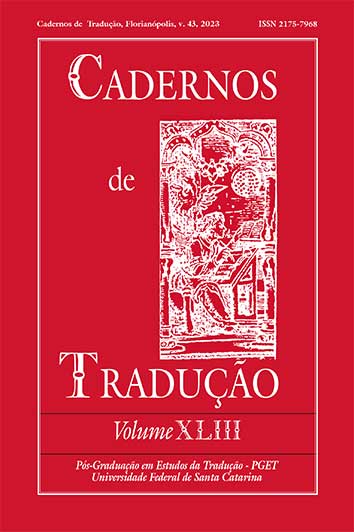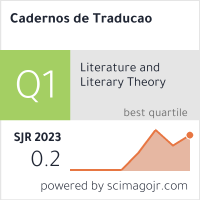"E então ele foi chapinhando até a porta": uma análise de tradução de modo de movimento em inglês para polonês e português brasileiro
DOI :
https://doi.org/10.5007/2175-7968.2023.e90393Mots-clés :
análise de tradução, padrões de lexicalização de modo de movimento, técnicas de traduçãoRésumé
O objetivo do artigo é analisar padrões de lexicalização de modo de movimento nas traduções de um texto literário em inglês para polonês e para português brasileiro. Apoiados na classificação talmiana de línguas com frame nos satélites e línguas com frame nos verbos, como também na teoria Thinking for Translating de Slobin, comparamos as frequências da presença do componente modo de movimento e a sua lexicalização com o auxílio de verbos de modo ou de verbos de trajetória nos textos sob escrutínio. Como esperado, os textos em inglês e em polonês contêm mais verbos de modo do que o texto brasileiro, embora, surpreendentemente, esse último expresse o modo com frequência apenas ligeiramente mais baixa do que o texto original. A análise de técnicas de tradução demonstrou que o texto brasileiro se mantém mais fiel na tradução do modo, enquanto o texto polonês exibe numerosas modulações e adições do modo, ausentes no texto original. Concluímos, portanto, que os padrões de lexicalização, influenciados pela direcionalidade linguística, resultam também das decisões criativas dos tradutores.
Références
Hickmann, Maya; Hendriks, Henriette; Soroli, Efstathia; Iakovleva, Tatina & Ji, Yinglin. “Space and language typology: encoding motion across languages”. 2012. Disponível em: https://citeseerx.ist.psu.edu/document?repid=rep1&type=pdf&doi=1aed534b9259057cfb95e460187fc412ff4257ec. Acesso em 3 mar. 2023.
Houaiss, Antônio; Villar, Mauro & Franco, Francisco. Dicionário Houaiss da língua portuguesa. Rio de Janeiro: Editora Objetiva, 2001.
Iacobini, Claudio. “Particle-verbs in romance”. In: Müller, Peter; Ohnheiser, Ingeborg; Olsen, Susan & Rainer, Franz (Orgs.). Word-formation. An International Handbook of the Languages of Europe. Berlin/New York: De Gruyter, 2015. p. 626-658. DOI: https://doi.org/10.1515/9783110246254
Ibarretxe, Iraide. “What translation tells us about motion: a contrastive study of typologically different languages”. International Journal of English Studies, 3(2), p. 151-175, 2003. https://revistas.um.es/ijes/article/view/48421/46371
Kopecka, Anetta. “Motion events in Polish. Lexicalization patterns and the description of manner”. In: Hasko, Victoria & Perelmutter, Renee (Orgs.). New approaches to slavic verbs of motion: paths for exploration. Amsterdam: John Benjamins Publishing, 2010. p. 225-246. DOI: https://doi.org/10.1075/slcs.115.14kop
Łozińska, Joanna. “The expression of path in three satellite-framed languages. A cognitive study of Polish, Russian and English”. Jezikoslovlje, 20(1), p. 31-61, 2019. DOI: https://doi.org/10.29162/jez.2019.2
Meirelles, Letícia. “Verbos de movimento do português brasileiro: evidências contra uma tipologia binária”. Revista Estudos Linguísticos, 27(2), p. 1101-1124, 2019. DOI: https://doi.org/10.17851/2237-2083.27.2.1101-1124
Milne, Alan. “Winnie-the-Pooh”. 03/01/2022. Project Gutenberg. Disponível em https://www.gutenberg.org/files/67098/67098-h/67098-h.htm. Acesso em 3 mar. 2023.
Milne, Alan. Ursinho Pooh. Tradução de Monica Stahel. São Paulo: Martins Fontes, 2018.
Milne, Alan. Kubuś Puchatek. Tradução de Irena Tuwim. Warszawa: Nasza Księgarnia, 2019.
Molés-Cases, Teresa. “Some advances in the study of the translation of manner of motion events: integrating key concepts of descriptive translation studies and ‘thinking for translating’”. Review of Cognitive Linguistics, 16(1), p. 152-190, 2018. DOI: https://doi.org.10.1075/rcl.00007.mol
Moura, Heronides & Badaracco, Lucas. “Translating verbs of motion from English to Portuguese: lexicon and constructions”. Cadernos de tradução, 39, p. 166-183, 2019. DOI: http://dx.doi.org/10.5007/2175-7968.2019v39n2p166
Moura, Heronides & Cambrussi, Morgana. Uma breve história da linguística. Petrópolis: Vozes, 2018.
Oxford Learner’s Dictionaries. Oxford: Oxford University Press, 2022. Disponível em: https://www.oxfordlearnersdictionaries.com/. Acesso em 3 mar. 2023.
Pavlenko, Aneta & Volynsky, Maria. “Motion encoding in Russian and English: moving beyond Talmy's typology”. The Modern Language Journal, 99, p. 32-48, 2015. DOI: https://doi.org/10.1111/modl.12177
Queriquelli, Luiz & Moura, Heronides. “Path marking on the satellite in Latin, old Portuguese, and vernacular Brazilian Portuguese”. Fórum Linguístico, 18, p. 6124-6136, 2021. DOI: http://dx.doi.org/10.5007/1984-8412.2021.e76267
Slobin, Dan. “Learning to think for speaking: native language, cognition, and rhetorical style”. Pragmatics, 1(1), p. 7-25, 1991. DOI: http://dx.doi.org/10.1075/prag.1.1.01slo
Slobin, Dan. “Verbalized events: a dynamic approach to linguistic relativity and determinism”. In: Niemeier, Susanne & Dirven, René (Orgs.). Evidence for linguistic relativity. Berlin: Mouton de Gruyter, 2000. p. 107-138. DOI: https://doi.org/10.1075/cilt.198.10slo
Slobin, Dan. “Relating narrative events in translation”. In: Ravid, Dorit & Shyldkrot, Hava (Orgs.). Perspectives on language and language development: essays in honor of Ruth A. Berman. Dordrecht: Kluwer, 2005. p. 115-130. DOI: http://dx.doi.org/10.1007/1-4020-7911-7_10
Słownik Języka Polskiego. Warszawa: Wydawnictwo Naukowe PWN, 2022. Disponível em: https://sjp.pwn.pl/. Acesso em 3 mar. 2023.
Talmy, Leonard. “Lexicalization patterns: semantic structure in lexical forms”. In: Shopen, Timothy (Org.). Language typology and syntactic description, vol. 3: grammatical categories and the lexicon. Cambridge: Cambridge University Press, 1985. p. 36-149.
Talmy, Leonard. “Properties of main verbs”. Cognitive Semantics, 2(2), p. 133-163, 2016. DOI: https://doi.org/10.1163/23526416-00202001
Viaro, Mario. A construção verbo + advérbio de lugar no romanche: herança latina ou decalque germânico? Tese (Doutorado em Letras Clássicas). Faculdade de Filosofia, Letras e Ciências Humanas, Universidade de São Paulo, São Paulo, 2001. https://www.teses.usp.br/teses/disponiveis/8/8143/tde-02022018-120013/pt-br.php
Téléchargements
Publiée
Comment citer
Numéro
Rubrique
Licence
(c) Tous droits réservés Cadernos de Tradução 2023

Ce travail est disponible sous la licence Creative Commons Attribution 4.0 International .
Autores mantêm os direitos autorais e concedem à revista o direito de primeira publicação, com o trabalho simultaneamente licenciado sob a Licença Creative Commons Atribuição 4.0 Internacional (CC BY) que permite o compartilhamento do trabalho com reconhecimento da autoria e publicação inicial nesta revista.
Autores têm autorização para assumir contratos adicionais separadamente, para distribuição não exclusiva da versão do trabalho publicada nesta revista (ex.: publicar em repositório institucional ou como capítulo de livro, com reconhecimento de autoria e publicação inicial nesta revista).










































